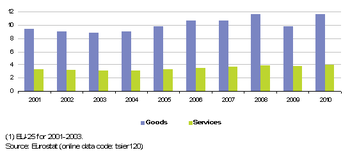Archive:International trade statistics introduced
- Data from October 2011. Most recent data: Further Eurostat information, Main tables and Database.
The European Union (EU) has a common trade policy, often referred to as the common commercial policy. In other words, the EU acts as a single entity on trade issues, including issues related to the World Trade Organisation (WTO). In these cases, the European Commission negotiates trade agreements and represents Europe’s interests on behalf of the EU Member States.

(% of GDP) - Source: Eurostat (bop_q_eu), (bop_q_euro), (bop_q_c) and (tec00001)
Main statistical findings
In 2010 the EU-27 economy returned to its previous trend of progressively more integration with the international economy in terms of its level of credits and debits relative to gross domestic product (GDP), having experienced a reversal in 2009. The average value of EU-27 trade flows of goods corresponded to 11.6 % of GDP in 2010, up from 9.8 % the previous year. The level of trade integration of services rose to 4.0 % of GDP in 2010, up from 3.9 % in 2008 and 3.8 % in 2009.
The global financial and economic crisis which started in 2007 had a considerable impact on the international exchange of goods and services and on the intensity of global financial flows and business activity. These effects are clearly evident in Figure 1, as the upward trend of EU trade in goods and services ceased in 2009. Nevertheless, the level of trade integration for goods in 2010 was the same as it had been in 2008, while for services the level of integration was slightly greater in 2010 than it had been in 2008.The EU-27 trade deficit for goods and services (see Table 1) was equivalent to -0.4 % of GDP in 2010, a smaller deficit than in the United States in 2009 (-2.7 %), whereas Japan recorded a combined goods and services surplus equivalent to 0.4 % of GDP (also in 2009). Among the Member States, the combined trade balance for goods and services in 2010 was positive in 15 Member States. Positive balances exceeded 10 % of GDP only in Ireland (18.4 %) and Luxembourg (46.6 %); in the case of Ireland this was due to a particularly large surplus for goods, while for Luxembourg it was due to a large surplus for services. The three largest trade deficits for goods and services were recorded in Romania (-5.4 % of GDP), Portugal (-6.5 %) and Greece (-6.6 %); in each case the deficit was driven by a relatively large deficit for goods.
Data sources and availability
Trade integration of goods and services is defined as the average value of debits and credits (summed and divided by two), presented in relation to GDP: the terms credits and debits are used for international trade in services which can roughly be considered to be equivalent to exports and imports. This indicator is calculated for both goods and services, based on balance of payments data; if the values increase over time, then the reporting territory became more integrated within the international economy. It is normal that smaller countries will display a higher degree of trade integration, as they are more likely to import a range of goods and services that are not produced within their domestic markets.
Context
The EU Treaty (TEU) (also called Treaty of Maastricht) establishes the overall aims and objectives of the EU’s trade policy: Article 3 sets out the general aims, including a highly competitive social market economy, aimed at full employment and social progress. Article 206 of the Treaty on the functioning of the Union (TFEU) explains how the common commercial policy must operate in principle: ’to contribute, in the common interest, to the harmonious development of world trade, the progressive abolition of restrictions on international trade and on foreign direct investment, and the lowering of customs and other barriers’. Article 207 of the TFEU sets out the scope, instruments and decision-making procedures, while Article 218 establishes the current inter-institutional procedure for the conclusion of international agreements, principally by the Council.
The EU’s trade policy aims to make the EU competitive in foreign markets. Being an open economy, the EU seeks to secure improved market access for its industries, services and investments, and to enforce the rules of free and fair trade. A coordinated trade policy takes on even greater importance in an era of globalisation, when economies and borders have opened up, leading to an increase in trade and capital movements, and the spread of information, knowledge and technology, often accompanied by deregulation. The economic impact of globalisation on the EU is felt through trade in goods and services, as well as through financial flows and the movement of persons linked to cross-border economic activity.
Globalisation acquires a higher profile when it is measured by actual trade flows. Within the EU, there are two main sources of trade statistics. One is international trade in goods statistics (ITGS), providing information on trade in merchandise goods, collected on the basis of customs and Intrastat declarations. This provides highly detailed information on the value and quantity (volumes) of international trade in goods as regards the type of commodity. The second main source is balance of payments statistics (BoP), which register all the transactions of an economy with the rest of the world. The current account of the BoP provides information on external trade in goods and services, as well as income (from employment and investment) and current transfers. For all these transactions, the BoP registers the value of exports (credits) and imports (debits).
An article on international trade in goods gives an overview of the EU’s trade in merchandise goods (within the ITGS framework), while an article on international trade in services provides an overview of its trade in services (within the BoP framework).
